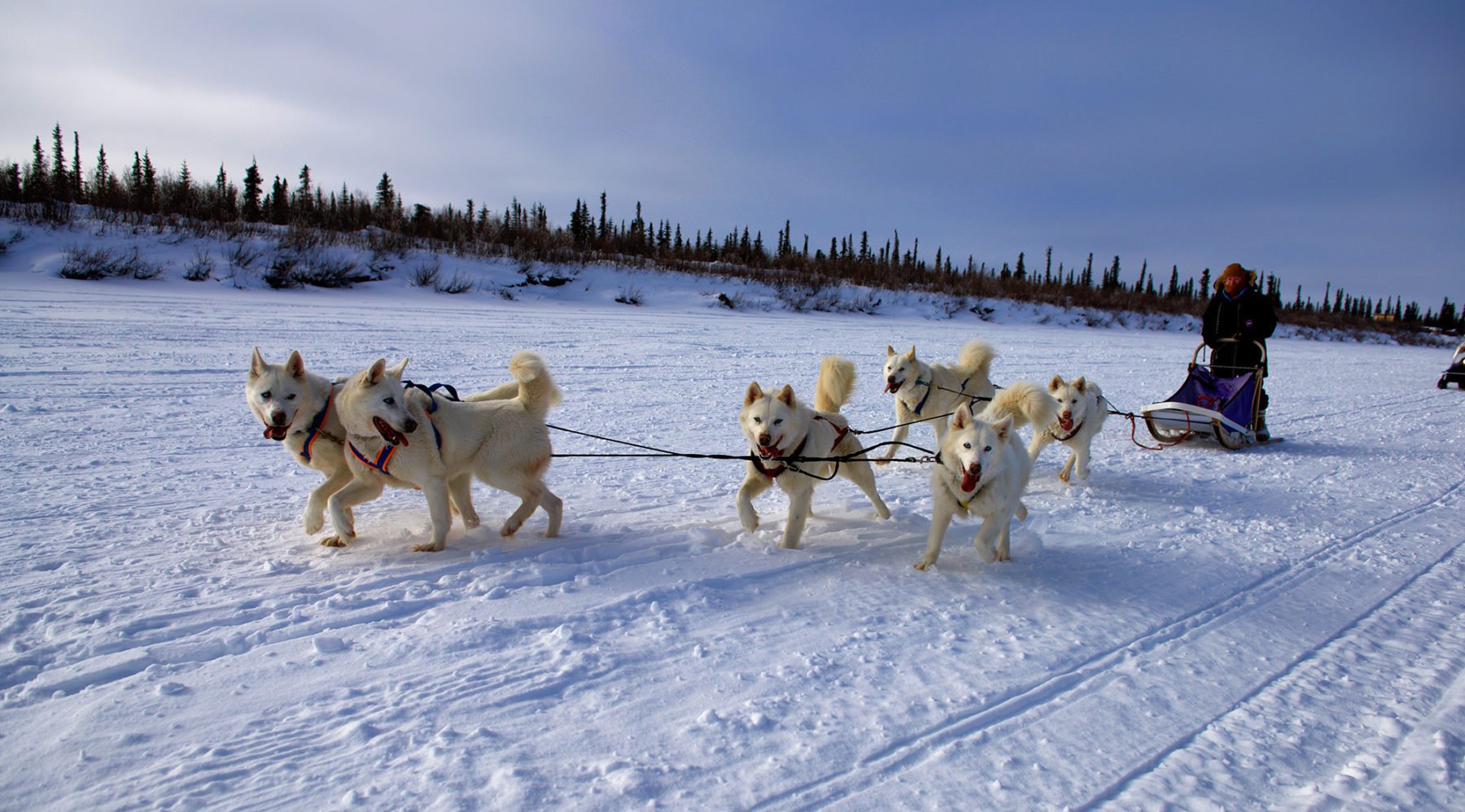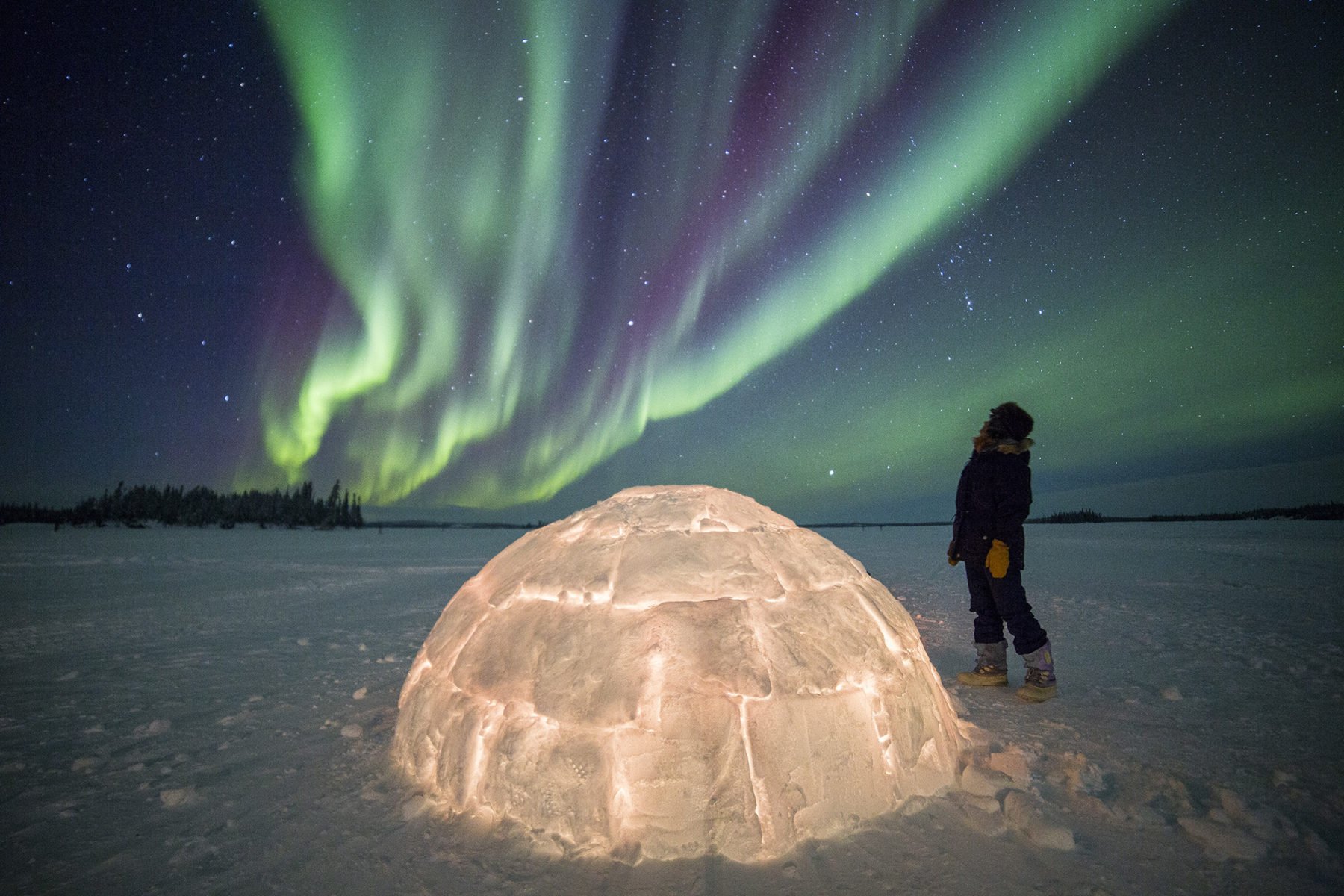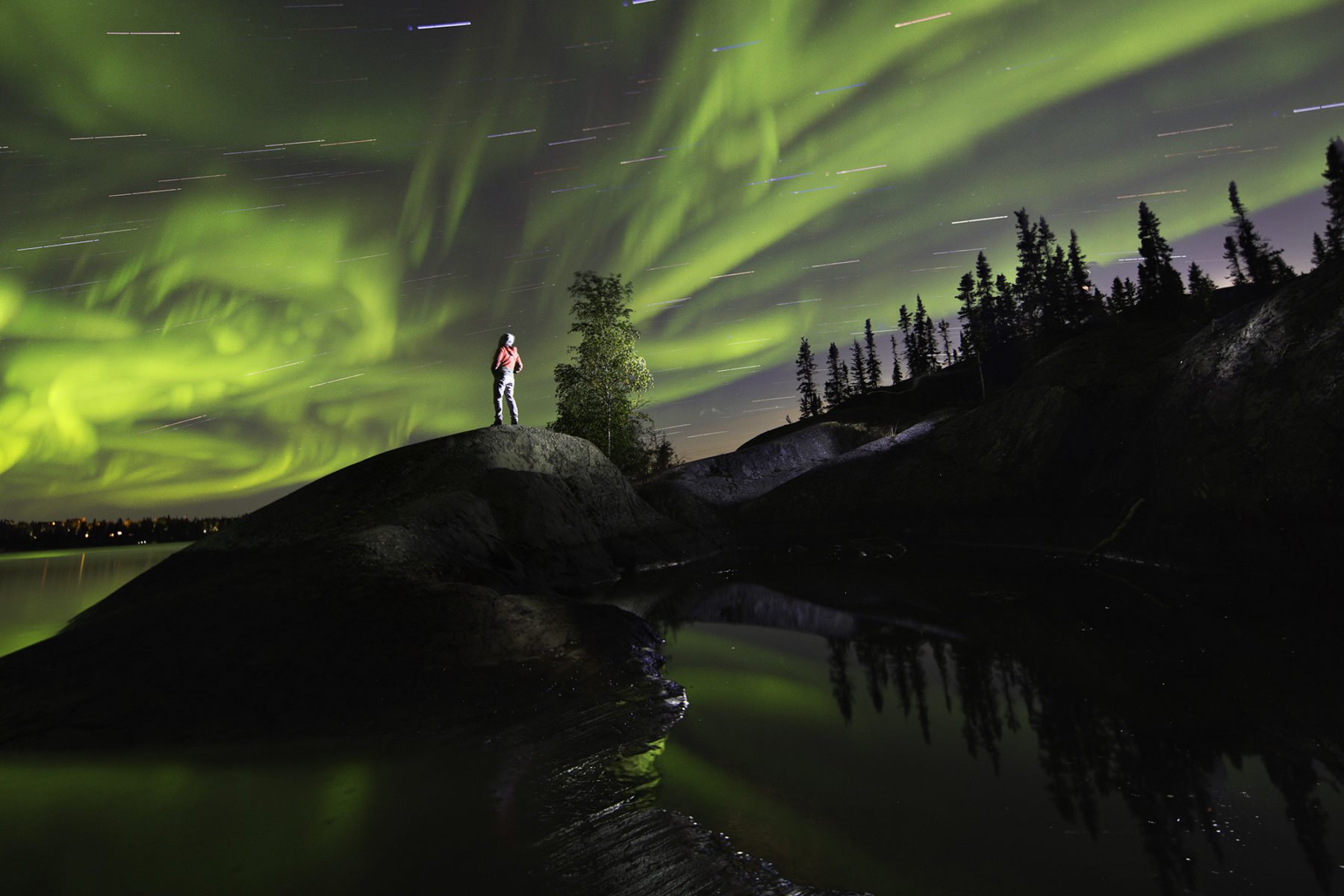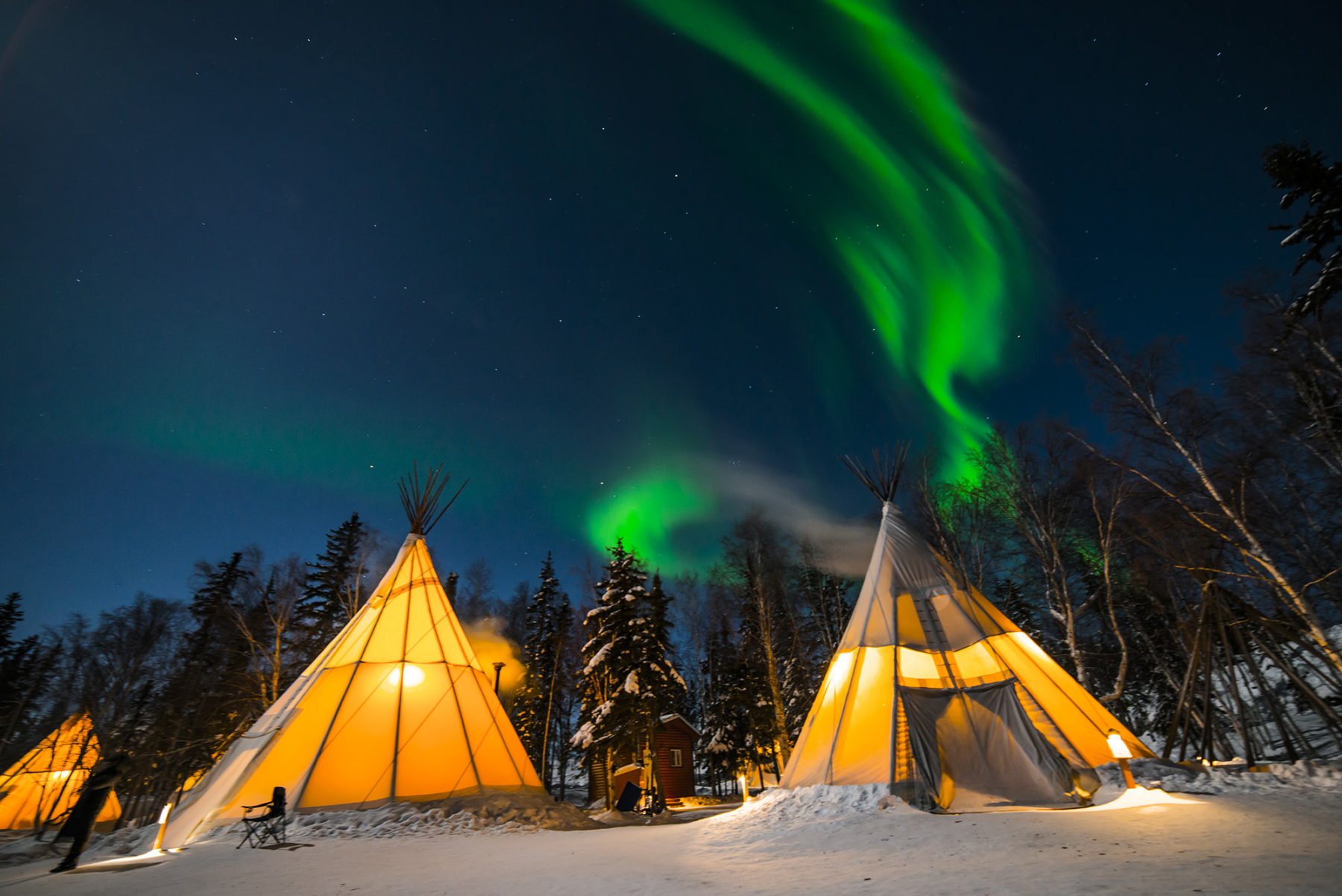“I was told it represents the spirits from the other world. And particularly when somebody close to you has passed on – a family member or a friend has passed on – when the Northern Lights are dancing, when they’re very vibrant and they’re dancing, that’s when they’re sending the message. They send the message back to you and the person saying, ‘Everything is okay now. I’m okay over here. You continue to do well in your life over there. We’re going to meet again one day soon, but there’s no need to be sad anymore.’ And the dancing represents that… It’s just incredible to get that feeling.”
Joe Bailey, a Dene man of Canada’s Northwest Territories (known as ‘Denendeh’ to the Dene people), and owner/operator of North Star Adventures in Yellowknife (the NWT capital), pauses, taking a moment to gather his thoughts before continuing to explain how the amazing natural phenomenon that is the Aurora Borealis, has shaped his life.
“Me and my brother, we were raised by our grandparents… in the traditional Dene lifestyle,” he continues. “I can remember being out at the Little Buffalo River in the middle of nowhere and living in a tent – it would sometimes be -40 degrees Celsius – and we were in just a canvas tent.
“After we’d done all our work of cutting the wood and keeping the camp clean, then we’d go play outside. And sometimes me and my brother would just lay in the snow and we’d just watch the Aurora Borealis. We were five and six years old, watching all the stars and just watching the Aurora go like crazy.”
A true natural wonder
Joe, along with all the other people fortunate enough to call the Northwest Territories home, lives in the literal shadow of one of the world’s most unique and colourful natural occurrences. Thankfully, for anyone looking to view the ‘dancing lights’ of the Aurora, you can. All you need to do is head to this ruggedly beautiful Canadian province that is the world’s best Aurora-viewing region. Here, you’ll not only find those magical lights putting on a show for roughly 200 days of each year, but a hell of a lot more. From a rich, thriving Indigenous culture and incredible outdoor activities, to the thriving capital city of Yellowknife, nestled on the northern shore of Great Slave Lake, to pristine lodges perched on the edge of one of the world’s largest bodies of water in part of Canada’s newest national park, these all combine with the NWT’s famous natural light show to provide more than enough reasons to spend plenty of time in one of the world’s still-wild places.
The secret behind the magic
The Aurora Borealis is something to behold, with its mix of emerald-green and rich red sprawling across the NWT night skies. Even though photographs and video footage capture its rich shimmering hues very well, being there physically and watching this performance of nature as it moves about the sky is that final element to the experience that can’t be replicated any other way. Standing there as the Aurora struts its stuff also offers up the question of just how this night-sky magic occurs.
The NWT is located in what is known as an “Auroral oval” (where the Aurora will display most strongly). This, to simplify, is a band around the earth that has been ‘pushed’ or moved by strong solar winds toward the dark (night) side of our planet. That solar wind disrupts the earth’s magnetosphere enough that particles from both the wind and the plasma of the magnetosphere ionise after precipitating in the upper atmosphere. The result is that brilliant and always varying emission of different light in the night sky, depending on how much oxygen and/or nitrogen is in the atmosphere (cool fact: the Aurora’s striking greens are courtesy of oxygen; those vibrant pinks are due to a large amount of nitrogen). Add in the fact the NWT has a very dry climate (and thus, few clouds) and you are, literally, only minutes away from clear skies once you leave the Yellowknife city limits, and it’s the ‘perfect storm’ for the Aurora. So, yeah, it’s definitely a complicated process, but as we all know; perfection never comes easy… As this video above shows, it’s always worth waiting for.
A tale of two seasons
The Northwest Territories’ northerly location means visitors can view the Aurora in both autumn and winter. After the province’s lengthy days of close to full sunlight during summer, the return of ‘night’ in August means nature’s famous light-show is ready to perform, with the southern parts of NWT copping three to five hours of night skies. It’s dark enough in the wee hours of the night to see the Aurora around Yellowknife by the first week of August..
For visitors keen to undertake other activity options while they’re in the NWT for the Aurora, the autumn season (around mid-August until the start of October) is great. Depending on where you are staying, daylight hours can be spent exploring Yellowknife itself, if you’re based in the city and doing day-trips out of it (this writer can vouch for the awesome pubs and dining in the city, plus a visit to Old Town is a must-do), or if you are based out at a remote lodge, you can tackle some of their many day-based experiences (more on this later) that can include hiking, wildlife-viewing, paddling (canoe or kayak), cultural tours (close to 50 per cent of the NWT population is indigenous), camping, boat tours on the water (with the Aurora’s lights often reflected on the surface), and fishing (think: huge trout and pike, plus other species). Often, during the evening if you’re out tackling some of the activities, the Aurora will be an accompaniment.

Winter brings with it snow, ice, and frozen lakes, providing a totally different ‘feel’ to the Aurora viewing experience. Usually running from November until late March, the contrast of the snow-clad landscape, the NWT’s immense now-frozen lakes and the vivid light-show in the night sky, ensures a breathtaking night-sky on most nights. Again, as well as the Aurora itself, there are some awesome other adventures you can partake in during winter. These include the ubiquitous dogsledding, ice-fishing, driving on ice roads (including the popular 6km Yellowknife-Dettah Ice Road, that links the city to the First Nation community of Dettah), and exploring the frozen lakes and waterways using skis, snowmobiles or on fat-bikes, with local guides. This frozen-world experience is a key factor in the NWT winter Aurora experience. And yeah, we agree; it’s tough to figure out which of the two seasons would be ‘best’ but, really, that’s a decision that doesn’t matter. They are both so unique in terms of the overall experience (not only the Aurora, but the plethora of other activities you can check out as well), that either one will make a life memory.
The views from the edge of the earth
Thaidene Nëné (“Land of the ancestors”) National Park Reserve is Canada’s newest national park and covers an amazing 27,000 square-kilometres of the East Arm of Great Slave Lake. Ratified in 2019, the park is remote and rugged, with its combination of huge lakeside cliffs (up to 100m high), the dramatic Douglas, Pethei and Kahocella peninsulas (ideal for hiking and camping), the numerous waterways that feed it, and a mix of forest and the vast arctic plains of the Barrenlands, home to muskox, caribou, bears, wolves and the joining point for a number of famous northern rivers. It is also culturally significant to the Dënesųłiné of the Dene people.
The national park is, today, also home to some brilliant lodges that are ideal destinations for those looking for a truly ‘remote’ Aurora viewing experience. Frontier Lodge was built originally as a lodge for the trophy fishing visitor (huge lake trout and Arctic grayling abound here), but now offers an awesome range of Aurora viewing-based stays of three, four or seven nights that incorporate other day-based activities, such as hiking (including on some of Great Slave Lake’s many small islands), wildlife viewing (there are plenty of muskox in this area, plus the potential to see wolves, bears and moose), sightseeing tours and with the potential to add on cultural activities.
It was the potential that the national park offered for this variety of activities that, according to Frontier Lodge Manager Corey Myers, led the lodge to expand their visitor offerings to not only Aurora focused experiences, but also Thaidene Nëné and cultural experiences (the lodge is 100 per cent Indigenous owned) as well.
“You always hear from clients; ‘I came for the fishing because I heard about it, but I want to come back for everything else’,” he says. “Or ‘I stuck to fishing and then realised on the last day there’s muskox, there’s hills to climb, there’s a whole community that I’ve never gotten to experience’. So now it’s cool to be able to offer that.”
And by cool, he means it: The Thaidene Nëné Experience includes – of course – Aurora viewing, plus the hiking, wildlife viewing and other activities from the lodge’s aurora-based experience. Impressively, it then adds a full cultural experience day, incorporating Dënesųłiné cultural programming that covers a tour through the Lutsel K’e community, storytelling and skills workshops, among other things. It’s not hard to see why fishing-only visitors soon realised the lodge and the national park itself, offer a far richer experience than first thought.

Katherine Johnson, Director of Sales and Marketing at Blachford Lake Lodge & Wilderness Resort offers similar comments regarding initial visitors to this pristine lodge, 100km east of Yellowknife, situated on the edge of pretty Blachford Lake, and how they, then the lodge owners, realised that, even though the fishing is top-level, above even that are the Aurora viewing opportunities. This lodge, built in the early 1980s, started off as a part-time (and popular) fishing lodge but soon expanded to take advantage of its brilliant location for viewing the NWT’s famous natural light show. As with Corey, for Katherine, the appeal of a remote lodge-stay for Aurora viewing is obvious, in many splendid ways, starting with the journey to the lodge, in a small float plane (or ski-plane in winter).
“The adventure does start when you hop on a bush plane in Yellowknife,” she says. “It’s about a 30-minute flight out to the lodge, and it’s a really scenic, beautiful flight. In the winter, you have the opportunity from the plane to see moose, lynx, wolves – all of the caribou sometimes if you’re lucky. It’s a beautiful flight… You don’t fly very high, so you can see everything below you.”
Katherine also offers a tip on the length of your stay in the NWT to maximise your chances of seeing the Aurora, saying a minimum of three nights is the recommendation she provides visitors. And it must work – Blachford Lodge has a high number of repeat visitors. And, as per other lodges, Blachford offers plenty to keep Aurora-chasing visitors busy during the day, too, with winter activities including snowshoeing, ice skating on the lake, hiking, ice-fishing and fat-bikes, as well as snowmobile tours.
There’s no doubt remote lodges offer a brilliant Aurora experience – and each one has its own unique flavour, whether that’s Frontier’s location in the amazing Thaidene Nëné, Blachford’s dreamy lakeside locale, or the equally remote Lac La Martre Lodge, located on its own small island in the middle of 2590 square-kilometre Lac La Martre itself (the only lodge there – yep, it does sound awesome). However, even more impressively for those planning their NWT journey, a lodge stay is just one of many options for Aurora experiences…
Many ways to join the dance
“Way back in 2007 I said, ‘I’m not going to call it Aurora Chasing or Aurora Viewing, I’m going to call it Aurora Hunting because I grew up hunting caribou, moose, and buffalo and so I wanted to use that concept,” Joe Bailey says, explaining how North Star Adventures’ ‘mobile’ Aurora viewing experience started. “Then all the customers in that first year, they said, ‘We’ve never seen this kind of tour before; This is more fun, this is more personal. This is more exciting. We suggest you continue to stay as Aurora Hunting’.
“So, we just focused on the analysing weather patterns, becoming experts in meteorology, the technical aspects of Aurora, and the solar sunspots, the behaviour of Aurora over the years…”
Joe and his team draw on not only the scientific information above, but their cultural knowledge (drawn from accumulated stories from Dene Elders over the generations) when hosting their unique ‘hunting’ trips that run in late summer and autumn. The key difference here is that Joe and his team are mobile, so they can drive to a number of different locations out from Yellowknife where they are based. This ability to not be bound to one location significantly ups the chances of a memorable Aurora viewing. For the more adventurous visitors, there’s also a snowmobile-based Aurora experience, plus a small-group, personal Aurora Teepee Tour, with more cultural enrichment as part of that.

Yellowknife is one of the world’s most perfectly located capital cities. Abutting North America’s deepest lake – Great Slave – and situated under Aurora-rich skies, this bustling small city offers aurora experiences nearly right outside the front door of your accommodation. This is ideal for those with less time (or money) but who want to tick off what is synonymous with this wild and wonderful province. Some highlights include Aurora Village, an Indigenous run/owned operation 30 minutes from the centre of Yellowknife beside the Ingraham Trail (Highway 4; this 70km route leads to pristine Tibbit Lake, via a number of other lakes, with campsites and boat launch sites at many of these). With its mix of autumn and winter Aurora experiences (or a package with a hotel in town) ranging from a day to longer, it is great for those with less time but who want a full Aurora viewing (and cultural) experience.
In town itself, one of the prettiest viewpoints would have to be the Bush Pilots Monument, located in the middle of Old Town (a must-visit on its own). At the top of the monument, you have 360-degree views around town and the lake. Even better, you can watch the Aurora and then head to one of Old Town’s great eateries. Win, win? Yep, we reckon so. Another top spot is Back Bay.
Everyone can see the light
It sounds like a cliché but there are no downsides to visiting the Northwest Territories for that lifetime Northern Lights experience. The location is, as mentioned earlier, perfect, and obviously is key to the success of those who seek the lights. But the NWT is so much more than that. Its unique landscape, encompassing mountains, forests, mighty rivers and lakes, the prolific wildlife, friendly locals, and a rich (and proud) Indigenous culture, mean NWT jams in all the ‘awesome’ that you can dream of in terms of adventurous travel inside its borders. And, finally and perhaps surprising for some of us Aussies, this Land Under Lights is not that far away; a flight to Vancouver, then a direct flight from Vancouver (or Calgary or Edmonton) to Yellowknife and you’ll be within near-touching distance of one of nature’s true wonders, with myriad other activities there on offer as well. We have a little more time before we can fly internationally again, so start planning that NWT aurora adventure with an Australian-based operator, such as Great Canadian Trails! Speaking of which…
Great Canadian Trails presents: Canada’s Subarctic Aurora Borealis and National Parks
Guided walking, off-the grid cultural experiences and sightseeing out of the Northwest Territories’ world-renowned aurora-viewing capital.
Experience the spectacular sights of one of Canada’s most pristine and wild provinces. Amidst the mesmerising colours of the Northern Lights and the untamed wilds, this journey will take you through spectacular Thaidene Nëné, Wood Buffalo and Nahanni national parks. An impressive array of flora and fauna exists throughout this province, known for its nature photography and wildlife viewing. Bald eagle and bison, loon and muskox, bear, moose and wolf all make the province’s remote northern tundra regions their homes. Its location directly beneath the Earth’s “Auroral oval,” ensures many successive nights throughout the autumn and winter to marvel at the aurora’s intense and flickering dance. Your tour is timed to provide ample viewing opportunities of this natural wonder. A thrilling bush plane flight amidst breathtaking canyons will lead you to Nahanni NP’s awe-inspiring Virginia Falls.
Date: September 2022
Length: 17 days / 16 nights (hotels, B&Bs and private cabins), September 2022.
More info and bookings: www.greatcanadiantrails.com/private/KUVGKV
Get to it!
FACT FILE
Getting there: The NWT is reached via daily direct flights from Vancouver, Calgary and Edmonton. There are direct flights from Australia’s eastern seaboard to Vancouver.
Best time to go: For the Northern Lights, the best time to go is mid- to late-August to early October, then December to March.
Accommodation: Yellowknife has a range of quality hotels and other accommodation types. For those looking for hotel accommodation, both The Explorer Hotel and Chateau Nova Yellowknife are excellent.
To book any of the remote lodges mentioned or a Yellowknife hotel and aurora experience, contact your preferred Australian tour operator or travel agent specialising in Canada.
Aurora viewing experiences: Besides those mentioned in this feature story, there are many other Northern Lights viewing operators. For info on all of these, see the Aurora section of the Northwest Territories Tourism website – www.spectacularnwt.com/what-to-do/aurora – where you will find links to information on day trips, longer stays, lodges and information on both the autumn and winter seasons. It’s worth noting that some lodges only open in autumn for Aurora viewing, while others offer it in both autumn and winter.
More info: NWT Tourism has an excellent website that is packed with info on traveling in the province. See www.spectacularnwt.com
